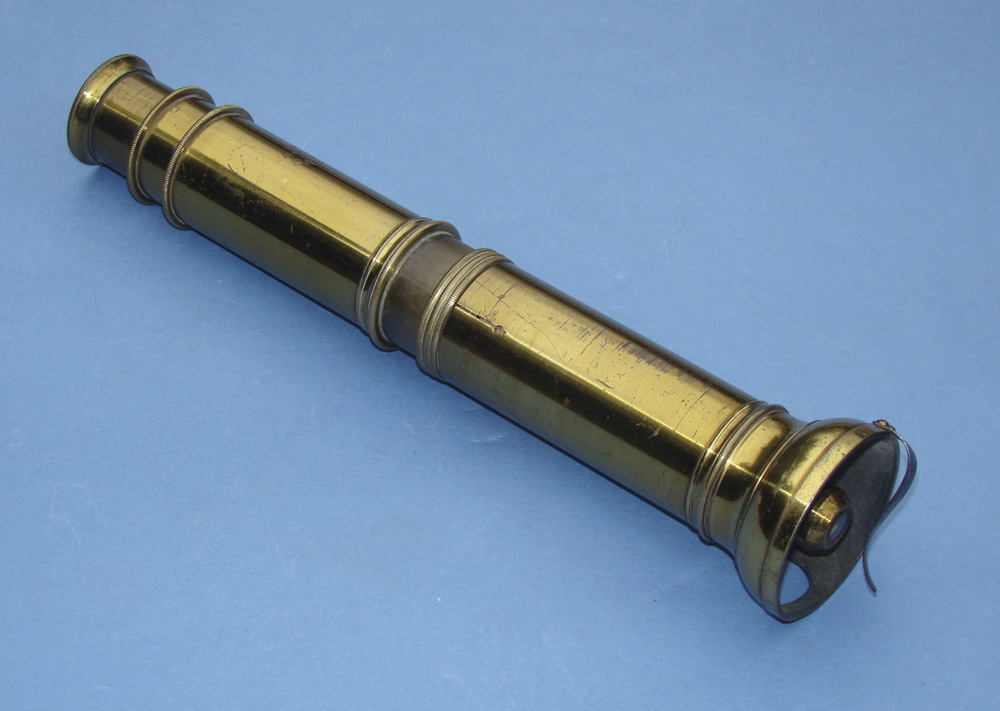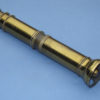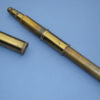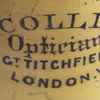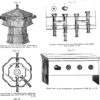HAND-HELD BEALE-TYPE DEMONSTRATION MICROSCOPE
Stock Number: 10122
$2800.
For sale, antique English Beale-type microscope. This substantial brass microscope extends from 8-3/4" to 14-3/4" (22 - 37 cm) by focusing drawtube and extension tube. It is equipped with original ocular and objective, giving fine images. A clamp ring permits tension adjustment on the drawtube for fixing the coarse focus position. Fine focus is by adjusting the eye extension tube position. At the specimen end a spring steel clip holds slides in place, and an oval cutout on the side allows illumination of opaque specimens. Condition is excellent, noting some small scratches to the fine original lacquer finish.
Circa
c.1865
Description
HAND-HELD BEALE-TYPE DEMONSTRATION MICROSCOPE, English, c. 1865, signed “C. Collins, Optician, 77 G’t. Titchfield St., London W.” on the main tube and “C36″ on the objective. This substantial brass microscope extends from 8-3/4″ to 14-3/4” (22 – 37 cm) by focusing drawtube and extension tube. It is equipped with original ocular and objective, giving fine images. A clamp ring permits tension adjustment on the drawtube for fixing the coarse focus position. Fine focus is by adjusting the eye extension tube position. At the specimen end a spring steel clip holds slides in place, and an oval cutout on the side allows illumination of opaque specimens. Condition is excellent, noting some small scratches to the fine original lacquer finish.
This is a rare example of the clinical demonstration microscope invented c. 1860 by Lionel S. Beale, Professor of Physiology at King’s College. It could be passed conveniently from student to student, or used by the field naturalist, etc. Carpenter, in The Microscope (1868) explains that it was also supplied mounted horizontally on a wood board, directly facing an adjustable oil lamp. Beale himself (How to Work with the Microscope, 1868) devotes three pages and several figures to its description and possible uses, even proposing that the present handheld “Pocket or Clinical microscope” could be arranged in multiples for classroom use, and illustrates four mounted in parallel, as well as eight in an octagonal piece of furniture surrounding a single lamp. (see illustration) Beale’s form is quite rare, even though Carpenter and Beale indicate that it was made by several of the principal London makers. Downing finds Charles Collins located at this address from 1863 to 1870.
Ask the Dealer
Dealer information
 TESSERACT
TESSERACT
David and Yola Coffeen both have enjoyed academic careers, as planetary astronomer and as linguist/educator. But since 1982 (yes, 1982!) they have been full-time dealers in early scientific and medical instruments, under the name Tesseract. Selling primarily by catalogue (over 100 issued so far) they also have a web presence at www.etesseract.com, and can be contacted at [email protected].




